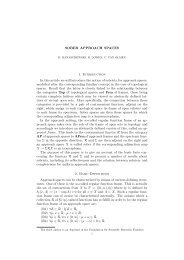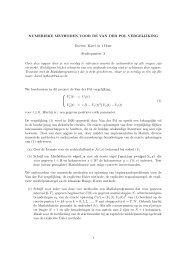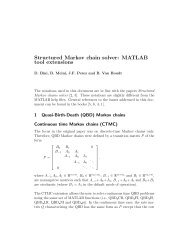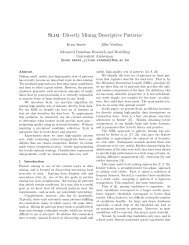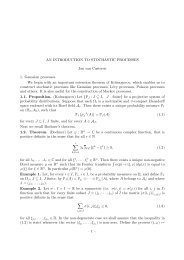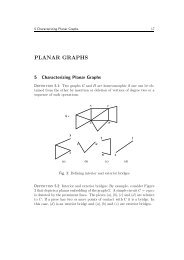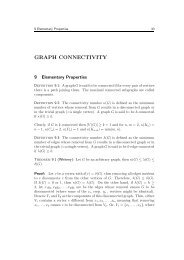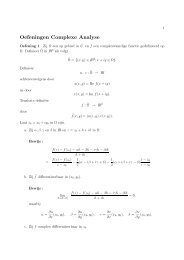Practical Rational Interpolation of Exact and Inexact Data Theory ...
Practical Rational Interpolation of Exact and Inexact Data Theory ...
Practical Rational Interpolation of Exact and Inexact Data Theory ...
Create successful ePaper yourself
Turn your PDF publications into a flip-book with our unique Google optimized e-Paper software.
A.2. <strong>Rational</strong> interpolation <strong>of</strong> vertical segments 123<br />
need to define a rule for the case that<br />
d<br />
ki =<br />
i=1<br />
We restrict ourselves to lexicographical orderings. We have chosen the backwards<br />
lexicographical ordering (i.e. ordering by kd first) by default, but this<br />
is merely a matter <strong>of</strong> taste. Priority can be assigned to any ki. In fact, any<br />
lexicographical ordering can be described in a simple inductive way once a<br />
preference is fixed upon the ki. Let<br />
⎧<br />
⎨<br />
Vn =<br />
⎩ (k1,... ,kd) ∈ N d ⎫<br />
d ⎬<br />
| kj = n<br />
⎭ .<br />
A lexicographical preference fixes the order <strong>of</strong> the elements <strong>of</strong> Vn.<br />
Example A.2.2. For d = 3, the lexicographical preference (1,2,3) means<br />
that first is sorted on k1, then on k2 <strong>and</strong> finally on k3. Hence the ordering<br />
<strong>of</strong> V1 is (0,0,1) < (0,1,0) < (1,0,0). The preference (1,3,2) means that<br />
first is sorted on k1, then on k3 <strong>and</strong> finally on k2. The ordering <strong>of</strong> V1 is then<br />
(0,1,0) < (0,0,1) < (1,0,0).<br />
Recall that it is our goal to enumerate over N d , not simply sorting elements.<br />
A first idea is to use the fact that for each n > 0, the elements<br />
<strong>of</strong> Vn can be decomposed in a unique way as the sum <strong>of</strong> n elements out <strong>of</strong><br />
V1. Here addition is understood component wise. This gives rise to a d-ary<br />
tree, which can be traversed efficiently in a breadth-first fashion. Provided<br />
that the tree is composed in the right way, breadth-first traversal <strong>of</strong> the tree<br />
corresponds exactly to the discussed enumeration <strong>of</strong> N d . For a lexicographical<br />
ordering at each level (Vn), its construction is as follows. The origin is<br />
always the root element, <strong>and</strong> has d children: the elements <strong>of</strong> V1. For ease <strong>of</strong><br />
notation, denote the elements <strong>of</strong> V1 by<br />
d<br />
i=1<br />
k ′ i .<br />
j=1<br />
ei = (0,... ,0,1,0,... ,0)<br />
where the position <strong>of</strong> 1 is on the i-th location. Each arrow connects a node<br />
(k1,...,kd) ∈ Vn−1 to a node (k ′ 1 ,...,k′ d ) ∈ Vn <strong>and</strong> has a label 1 ≤ i ≤ d. A<br />
label i means that<br />
(k ′ 1 ,...,k′ d ) = (k1,... ,kd) + ei<br />
The way that children are generated depends on the chosen lexicographical<br />
preference. If an arrow with label i enters a node, then arrows with



